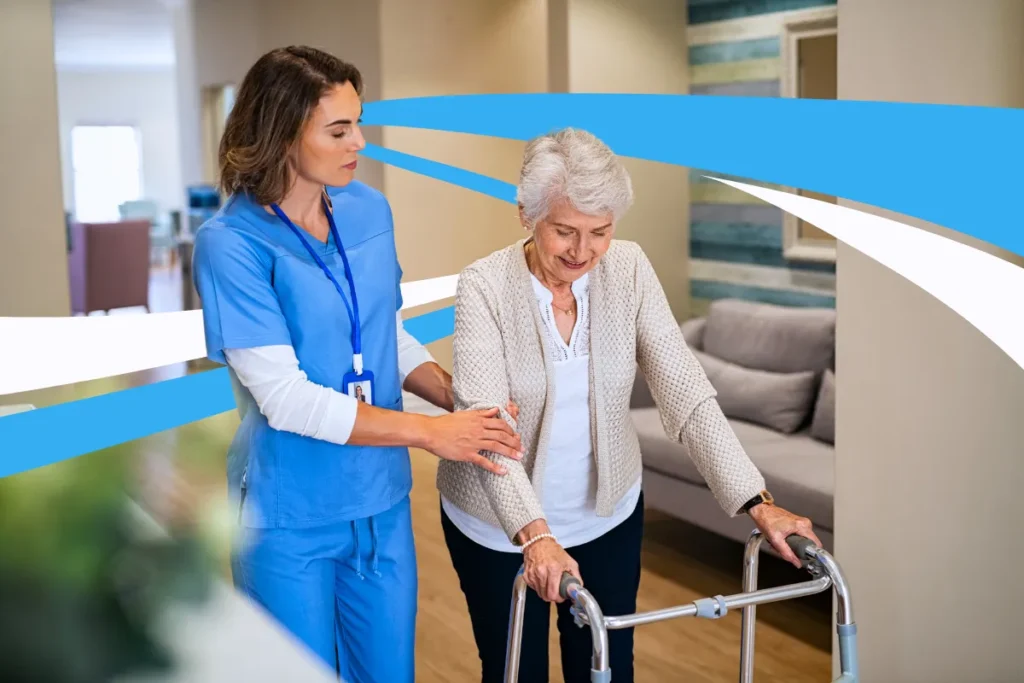Falls are a leading cause of injury among the elderly, often resulting in hospitalization, decreased mobility, and a decline in overall health. Daily living assistance can play a crucial role in fall prevention, supporting individuals in maintaining balance, confidence, and independence while reducing the risk of accidents. In this blog post, Dieset Home Care Services delves to the various ways that daily assistance can significantly minimize the risk of falls, fostering a safer and more supportive environment for elderly individuals.
Understanding the Risks of Falls Among the Elderly

Falls are particularly dangerous for older adults due to age-related changes like weakened muscles, loss of bone density, and slower reflexes. As the body ages, individuals may experience issues with vision, balance, and coordination, making them more susceptible to tripping or losing balance. Additionally, chronic health conditions such as arthritis, osteoporosis, or diabetes can increase the likelihood of falls. Understanding these risk factors is essential, as it helps in identifying the specific support needed to prevent accidents.
Falls among the elderly pose significant health risks, often leading to severe injuries such as fractures and head trauma. Factors contributing to falls include impaired balance, muscle weakness, and environmental hazards. Recognizing these risks is crucial for prevention. Daily living assistance services can play a vital role by providing support with mobility, home safety modifications, and personalized care plans, ultimately enhancing the quality of life and reducing the likelihood of falls among seniors.
The Role of Mobility Support in Fall Prevention
One of the most significant contributions of daily living assistance is mobility support, which includes physical support while moving around, helping with mobility aids like walkers or canes, and ensuring safe transfers from one position to another. Mobility support helps prevent situations where individuals might stumble, trip, or lose their balance. A caregiver’s presence during activities like getting up from a chair, climbing stairs, or walking across uneven surfaces can be vital in reducing the risk of a fall.
Environmental Modifications to Enhance Safety
Daily living assistance also includes making necessary modifications within the home environment to reduce potential hazards. This can involve rearranging furniture for easier navigation, ensuring good lighting in all areas, and removing obstacles such as loose rugs or clutter. A caregiver can help assess the home and recommend essential changes to make the living space safer. These modifications can significantly impact fall prevention, as they reduce the chance of accidental trips and provide a stable environment conducive to safe movement.
Assisting with Activities of Daily Living (ADLs)
Activities of Daily Living (ADLs), such as bathing, dressing, and toileting, are often situations where falls are most likely to occur due to the physical strain or balance required. Daily living assistance ensures that individuals receive support during these activities, which minimizes the chances of slipping or losing balance. A caregiver can assist with proper bathing techniques, help with safe transfers in and out of bathtubs, and provide stable support when changing clothes, all of which contribute to a safer daily routine.
Medication Management and Its Impact on Balance
Many elderly individuals take multiple medications to manage chronic conditions. However, certain medications can have side effects like dizziness, drowsiness, or changes in blood pressure, which can increase fall risk. Daily living assistance often includes medication management, ensuring that individuals take their medications correctly and at the right times. A caregiver’s oversight can help reduce the risk of adverse side effects that might impair balance or alertness, thereby preventing falls linked to medication issues.
The Psychological Benefits of Having a Caregiver
The psychological comfort of having a caregiver nearby can positively affect an individual’s confidence and stability. Fear of falling is common among elderly individuals, which can lead to anxiety and hesitation when moving. This fear can paradoxically increase the risk of falls, as individuals might tense up or avoid necessary movement. Daily living assistance can ease these fears by providing a stable presence, encouraging safe activity, and allowing individuals to move more freely and confidently within their environment.
Exercise and Physical Therapy Support
Regular physical activity and exercises designed to improve balance and strength are critical in fall prevention. Daily living assistance often includes helping individuals engage in appropriate exercise routines, whether they involve walking, stretching, or specific balance exercises recommended by a physical therapist. With a caregiver’s support, individuals are more likely to follow their exercise routines, maintain physical strength, and enhance their stability, all of which contribute to a reduced risk of falling.
Nutritional Assistance to Strengthen Muscles and Bones
Good nutrition is essential for maintaining muscle strength and bone density, both of which play a role in fall prevention. Caregivers can assist with meal planning and preparation, ensuring a balanced diet rich in calcium, vitamin D, and protein to support musculoskeletal health. By helping elderly individuals maintain a healthy diet, daily living assistance strengthens the body, which in turn improves balance, coordination, and resilience against injury in case of a fall.
Nutritional assistance plays a crucial role in strengthening muscles and bones, particularly through a balanced intake of protein, calcium, and vitamin D. Foods like lean meats, dairy products, leafy greens, and fish contribute essential nutrients for muscle repair and bone density. For individuals requiring support, feeding assistance services can ensure access to these vital nutrients, helping to improve overall health and physical resilience, particularly in older adults or those with mobility challenges.
Monitoring Health Conditions and Physical Limitations
For individuals with chronic health conditions, daily monitoring of symptoms and physical limitations is vital in preventing falls. Caregivers can observe changes in mobility, balance, or energy levels and adapt daily routines accordingly. If a person shows signs of fatigue, dizziness, or joint stiffness, a caregiver can provide additional support or modify activities to prevent potential falls. This responsive care ensures that any emerging issues are addressed promptly, maintaining a safe and adaptive environment.
Social Engagement and Reduced Isolation
Isolation and loneliness can contribute to reduced physical activity, which in turn leads to muscle weakness and increased fall risk. Daily living assistance fosters social engagement, as caregivers encourage individuals to participate in activities, go on walks, and engage in light exercise. This support not only promotes physical health but also enhances mental well-being, contributing to a more active lifestyle that reduces fall risks associated with inactivity.
Using Assistive Devices Correctly
Many elderly individuals rely on assistive devices like canes, walkers, or grab bars to move safely. However, improper use of these devices can increase the risk of falls rather than reduce it. Daily living assistance includes training and oversight to ensure that individuals use their assistive devices correctly and comfortably. Caregivers can provide reminders on proper usage, check for any needed adjustments, and even accompany individuals during device use to offer added stability.
Encouraging Safe Footwear Choices
Footwear plays an essential role in maintaining balance and stability. Elderly individuals may not always recognize the importance of wearing shoes with proper grip, support, and comfort. A caregiver’s advice and guidance on choosing appropriate footwear can help in preventing slips and trips. Daily living assistance can include reminders about wearing shoes indoors and ensuring that shoes are in good condition, with non-slip soles that provide adequate support.
Fall Prevention Programs and Educational Support
Daily living assistance can also include access to fall prevention programs that focus on education and training for both caregivers and individuals. Caregivers can implement techniques learned in these programs, such as exercises to improve balance or tips for safe mobility. These programs offer valuable strategies that further support individuals in maintaining safety and confidence in their movements, reducing the likelihood of falls.
Fall prevention programs are essential for promoting safety among individuals, especially the elderly. These programs often include education on balance exercises, home modifications, and proper footwear. Home care services can play a crucial role by providing personalized support, ensuring the living environment is safe, and helping with mobility training. By integrating fall prevention strategies into home care, clients can maintain their independence while significantly reducing the risk of falls and related injuries.
Emergency Preparedness and Rapid Response
In situations where a fall does occur, the immediate response can make a significant difference in the outcome. A caregiver can provide rapid assistance, helping to assess any potential injuries and ensuring that individuals receive medical attention if necessary. Daily living assistance includes establishing emergency protocols, equipping homes with alert systems, and providing support during emergencies. This preparedness not only offers peace of mind but also ensures that any fall is addressed quickly and effectively, minimizing the risk of further complications.
Emotional Support and Reassurance
Emotional well-being is closely tied to physical health, and feelings of insecurity or fear can increase the risk of falls. Daily living assistance offers companionship and emotional support, which helps individuals feel reassured and reduces anxiety related to movement and balance. When elderly individuals feel emotionally supported, they are more likely to engage in healthy activities that promote mobility and strength, leading to better fall prevention outcomes.
Integrating Technology for Added Safety
Technology, such as fall detection sensors, wearable devices, and home monitoring systems, can enhance fall prevention efforts. Caregivers who are knowledgeable about these technologies can incorporate them into daily care routines, offering an extra layer of safety and monitoring. By integrating technology, caregivers can receive alerts in case of a fall, track physical activity, and even monitor vital signs, all of which contribute to a safer living environment.
Reducing Healthcare Costs and Improving Quality of Life
Falls can lead to costly hospitalizations and long-term healthcare needs, impacting both the individual’s quality of life and financial stability. Daily living assistance plays a preventive role that not only reduces healthcare costs but also preserves independence and enhances life quality. By preventing falls, caregivers help individuals maintain a higher level of autonomy, mobility, and engagement in daily activities, leading to a fulfilling and safer lifestyle.
FAQs
What is the importance of carers in falls prevention?
Carers provide emotional support, which can help reduce anxiety and fear about falling. This can encourage more active engagement in activities that promote strength and balance, reducing the risk of falls.
What is the importance of falls prevention?
Three million seniors seek emergency treatment for a fall. One of every five falls results in broken bones or a head injury. About 300,000 older adults require hospitalization for hip fractures.
What are the benefits of fall prevention programs?
Many risk factors for falls, ranging from muscle weakness to improper footwear, can be changed to reduce this risk. ACL-funded programs help participants improve strength, balance, and mobility, and educate them on reducing fall risk factors. Some programs also involve medication reviews and assess home hazards.
What is the goal of fall prevention?
Falls prevention aims to balance patient safety and personal freedom to do things. The goal is to maintain and maximize quality of life, while minimizing each individual resident’s risk of having a fall resulting in an injury.
Why is fall prevention important in hospitals?
Inpatient falls result in significant physical and economic burdens to patients (increased injury and mortality rates and decreased quality of life) as well as to medical organizations (increased lengths of stay, medical care costs, and litigation).
Conclusion
Daily living assistance is a cornerstone of fall prevention, offering elderly individuals the support they need to maintain balance, safety, and independence. Through a combination of physical support, environmental adjustments, medication management, and personalized care, daily assistance mitigates many of the risks associated with falls. The benefits extend beyond physical health, encompassing emotional well-being, social engagement, and an improved quality of life. Investing in daily living assistance is not just about preventing falls; it’s about empowering individuals to live safely, confidently, and with dignity.
